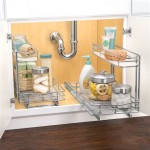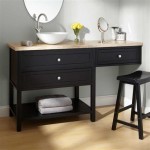Understanding the 22 x 19 Bathroom Vanity Unit
The 22 x 19 bathroom vanity unit represents a specific size classification in bathroom fixtures, indicating a vanity with a width of 22 inches and a depth of 19 inches. This compact size makes it a popular choice for smaller bathrooms, powder rooms, or spaces where maximizing floor space is crucial. Understanding the dimensions, materials, styles, and installation considerations associated with this type of vanity is essential for making informed purchasing decisions and achieving a functional and aesthetically pleasing bathroom design.
This article will delve into the various aspects of the 22 x 19 bathroom vanity unit, examining its suitability for different bathroom layouts, the materials commonly used in its construction, available style options, and the factors to consider during installation. The aim is to provide a comprehensive overview that aids in selecting the right vanity unit for specific needs and design preferences.
Space Optimization and Suitability
The primary advantage of a 22 x 19 vanity unit lies in its compact footprint. This size is particularly well-suited for spaces with limited square footage, such as small bathrooms in apartments, condominiums, or guest bathrooms. In these environments, a larger vanity could overwhelm the space, potentially obstructing movement and making the room feel cramped. The smaller dimensions of the 22 x 19 vanity allow for efficient use of available space, leaving room for other essential fixtures and amenities.
Furthermore, a 22 x 19 vanity can be a practical solution for powder rooms, which are typically designed for handwashing and quick freshening up. These rooms often prioritize aesthetics and functionality over extensive storage. The compact size of the vanity ensures that it doesn't detract from the overall design while providing essential utility. Considerations should be given to door swing clearances and walking paths within the bathroom to determine the optimal placement of the vanity.
Although ideal for smaller bathrooms, the 22 x 19 vanity may not be suitable for larger bathrooms where additional storage space is required. In such cases, a larger vanity unit, or a combination of multiple storage solutions, might be more appropriate. It is essential to assess the storage needs prior to selecting a vanity size to ensure that it meets operational requirements.
When evaluating the suitability of a 22 x 19 vanity, consider the overall layout of the bathroom. Note the placement of the toilet, shower, and other fixtures. Ensure that the vanity will not obstruct access to these other components. Mocking up the vanity’s footprint with cardboard or tape can be a helpful method for visualizing its impact on the room's flow and assessing its suitability.
Materials and Construction
The materials used in the construction of a 22 x 19 bathroom vanity significantly impact its durability, aesthetics, and overall cost. Different materials offer varying levels of resistance to moisture, wear and tear, and require different levels of maintenance. Common materials include solid wood, plywood, MDF (Medium Density Fiberboard), and particleboard, each with its own set of advantages and disadvantages.
Solid wood is often considered the premium choice, providing exceptional durability and a timeless aesthetic. Hardwoods like oak, maple, and cherry are frequently used for their strength and resistance to warping. However, solid wood vanities tend to be more expensive and may require more careful maintenance to prevent moisture damage. Sealing and proper ventilation are crucial in preventing moisture-related issues.
Plywood is an engineered wood product composed of layers of wood veneer glued together. It offers a good balance of strength, stability, and affordability. Plywood is less susceptible to warping than solid wood and provides a stable surface for attaching hardware and countertops. High-quality plywood with a moisture-resistant finish is a suitable choice for bathroom vanities.
MDF is another engineered wood product made from wood fibers compressed with resin. It provides a smooth, consistent surface that is ideal for painting or applying veneers. MDF is more affordable than solid wood or plywood, but it is also more susceptible to moisture damage. MDF vanities typically require a durable finish to protect them from humidity and splashes.
Particleboard is the least expensive option, composed of wood chips glued together. It is generally less durable and more prone to moisture damage than other materials. While particleboard vanities can be budget-friendly, their long-term durability may be a concern in a moisture-prone bathroom environment. If a particleboard vanity is chosen, ensure it has a high-quality, moisture-resistant coating.
The countertop material is also a critical consideration. Common countertop materials for 22 x 19 vanities include granite, marble, quartz, solid surface, and ceramic tile. Granite and marble are natural stone options that offer durability and elegance, but they can be porous and require sealing. Quartz is an engineered stone that is highly durable, non-porous, and low-maintenance. Solid surface materials are also non-porous and can be molded into seamless designs. Ceramic tile provides a cost-effective and versatile option.
Style Options and Design Considerations
The style of a 22 x 19 bathroom vanity should complement the overall design aesthetic of the bathroom. Numerous style options are available, ranging from traditional to contemporary, and from minimalist to ornate. Selecting the right style can significantly enhance the visual appeal of the bathroom and create a cohesive design scheme.
Traditional vanities often feature ornate detailing, raised panel doors, and decorative hardware. These vanities are typically constructed from solid wood or wood veneers and finished with rich stains or paints. Traditional vanities evoke a sense of classic elegance and can be paired with traditional faucets, lighting fixtures, and accessories.
Contemporary vanities tend to have clean lines, minimalist designs, and sleek hardware. They often feature flat-panel doors, integrated sinks, and floating designs. Contemporary vanities are typically constructed from MDF or plywood and finished with high-gloss lacquers or matte paints. These vanities create a modern and sophisticated look.
Transitional vanities blend elements of both traditional and contemporary styles. They may feature simple door designs with subtle detailing and a neutral color palette. Transitional vanities offer versatility and can be adapted to suit a variety of bathroom designs.
The choice of sink is another important design consideration. Under-mount sinks offer a seamless look and are easy to clean. Over-mount or drop-in sinks are installed on top of the countertop and provide a more traditional appearance. Vessel sinks sit on top of the countertop and can add a unique focal point to the vanity. The type of sink chosen should complement the style of the vanity and the overall design of the bathroom.
Hardware, such as knobs and pulls, can also significantly impact the style of the vanity. Simple, understated hardware is suitable for contemporary vanities, while more ornate hardware is appropriate for traditional vanities. The hardware should be consistent with the other metal finishes in the bathroom, such as the faucets and lighting fixtures.
Color is a crucial element in bathroom design. Neutral colors like white, gray, and beige are versatile and can create a calming and spacious feel. Bold colors can add personality and visual interest. The color of the vanity should complement the other colors in the bathroom, such as the walls, floor, and accessories.
Finally, consider the storage needs when selecting a vanity. Some 22 x 19 vanities offer a single cabinet with limited storage space, while others feature drawers or open shelving. Choose a vanity with sufficient storage space to accommodate toiletries, towels, and other bathroom essentials.
Installation Considerations
Proper installation is crucial for ensuring the functionality and longevity of a 22 x 19 bathroom vanity. Installation involves several steps, including preparing the space, connecting the plumbing, and securing the vanity to the wall. While some homeowners may choose to install the vanity themselves, professional installation is recommended for those without plumbing or carpentry experience. Incorrect installation can lead to leaks, damage, and other problems.
Before beginning the installation process, ensure that the water supply to the bathroom is shut off. Remove the old vanity, if applicable, and clean the area. Check the plumbing connections and ensure they are compatible with the new vanity. It may be necessary to adjust the plumbing to accommodate the new sink and faucet.
Position the vanity in its designated location and level it using shims if necessary. Secure the vanity to the wall using screws, making sure to align the screws with wall studs for maximum stability. Connect the drainpipe and water supply lines, ensuring that all connections are tight and leak-free.
Install the countertop and sink according to the manufacturer's instructions. Apply a bead of caulk around the edges of the sink to seal it to the countertop and prevent water from seeping underneath. Install the faucet and connect the water supply lines. Test the sink and faucet to ensure they are functioning properly and that there are no leaks.
Finally, install the hardware, such as knobs and pulls. Clean the vanity and surrounding area. Inspect the installation to ensure that everything is properly aligned and secure. If any problems are detected, address them promptly to prevent further damage.
When installing a 22 x 19 vanity, adherence to plumbing codes and regulations is essential. These codes vary by location and specify requirements for water supply, drainage, and ventilation. Failure to comply with these codes can result in fines and other penalties.
Consider hiring a licensed plumber to handle the plumbing connections. A professional plumber has the expertise and tools to ensure that the plumbing is installed correctly and safely. This can prevent costly repairs and ensure compliance with local codes.

Duravit Brioso 19 X 22 18 Two Drawer Floor Standing Vanity Unit I Us Bath

Duravit Brioso 51 X 22 19 Two Drawer Wall Mount Vanity Unit In Oa Us Bath

Duravit Brioso Br43140 48 X 22 19 Two Drawer Wall Mount Vanity Un Us Bath

Duravit Brioso 51 X 22 19 Two Drawer Wall Mount Vanity Unit In Ta Us Bath

Duravit Brioso 24 X 22 19 Two Drawer Wall Mount Vanity Unit In Wh Us Bath

Bathroom Sink Adv210 22 X 19 36 China Solid Wood Vanity Vanities Made In Com

Duravit Brioso 32 X 22 19 Two Drawer Wall Mount Vanity Unit In Wa 2024 Mounted Units

Duravit Brioso 32 X 22 19 Two Drawer Wall Mount Vanity Unit In Wh Us Bath

Home Decorators Collection Stockley 18 In W X 19 D 22 H Single Sink Floating Bath Vanity Forest Elm With White Cultured Marble Top B36x20247 The Depot

Modern Bathroom Vanity Set Mirror Included Rectangular Sink Drawer Clearhalo
Related Posts







